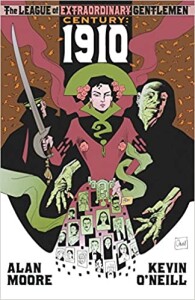 I confess to a bit of ambivalence about Alan Moore’s work. Swamp Thing didn’t really catch me at all, Watchmen left me cold (it seems to me that if you’re going to do a successful parody, you can’t take yourself too seriously), but WildC.A.T.S. looks interesting. So then came the opportunity to take a look at The League of Extraordinary Gentlemen: Century: 1910.
I confess to a bit of ambivalence about Alan Moore’s work. Swamp Thing didn’t really catch me at all, Watchmen left me cold (it seems to me that if you’re going to do a successful parody, you can’t take yourself too seriously), but WildC.A.T.S. looks interesting. So then came the opportunity to take a look at The League of Extraordinary Gentlemen: Century: 1910.
This installment (the first of three to be issued under the overall title) is titled “What Keeps Mankind Alive?” What, indeed? If you’ve read The League of Extraordinary Gentlemen and The Black Dossier, you know the context:
In an alternate universe, some of the most noted characters in Victorian fiction are recruited to form a covert military unit working for British Intelligence. There are tantalizing references here and there to earlier groups similarly composed of literary figures. The 19th-century universe is also populated by other fictional heroes and villains, slyly referenced here and there throughout the text as our heroes set forth on their missions.
This third title Century gives us the League and a situation full of dire portents. Captain Nemo is on his deathbed on Lincoln Island and is trying to talk his daugher, Janni, into taking his place; she deserts him and the island by swimming out to a passing steamer and winding up in London, where she takes the name “Jenny Diver.” Also on the ship is Jack MacHeath, believed by Mycroft Holmes, head of military intelligence, to be Jack the Ripper. Meanwhile, Thomas Carnacki, League member and supernatural detective, is having visions of major carnage in London, orchestrated by a cult headed by Simon Iff. Mina Murray thinks it might have something to do with the impending coronation of George V. There is also rumor of a “black raider” seen offshore.
Frankly, the plot, while layered and complex enough to be interesting in itself, is probably the least interesting part of this story. Most of the fun is making the connections between the story and the characters who show up in it. Orlando, one of the League, for example, was a puzzle for a while – described initially as a “man-woman,” he is a somewhat overdrawn, stereotypical fairy. It took me a bit to make the connection with Virginia Woolf’s Orlando, in which the protagonist undergoes a mystical and magical sex change while serving as Ambassador to the Sublime Porte.
MacHeath was fairly obvious, especially when a series of murders of prostitutes resumes with his reappearance. The fun part of that one was the fact that MacHeath accompanies himself with a song (you can tell it’s song because the dialogue balloons have musical notes scattered through them), a motif continued by one of the prostitutes who inhabits the dive Jenny finds work in. Three-Penny Opera, anyone? It also happens to be a wonderful formal device, allowing Moore to comment on the action “on-stage,” as it were. There’s even a big musical finale, with dancers.
Century is full of touches like this, all of which serve to make a complex story with a lot of layers. The nice thing about it is that Moore doesn’t beat you over the head with it – it’s all there, and you get to put the pieces together.
Kevin O’Neill’s drawing took some getting used to. It’s fairly abstract for a Western comic, somewhat reductive, and treads a fine line between comic realism and caricature. Layouts are predictable, and the drawing doesn’t really shoulder a great deal of the narrative load, but it helps set the feel of the story. It all works.
The volume ends with a selection of vignettes titled “Minions of the Moon” by John Thomas, most sketching events involving members of the League that take place in or about 1964 – the period of the next volume in this series. This could be interesting.
(Top Shelf Productions/Knockabout Comics, 2009)
